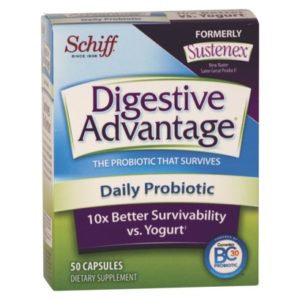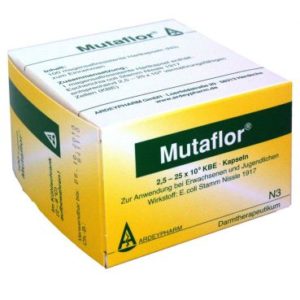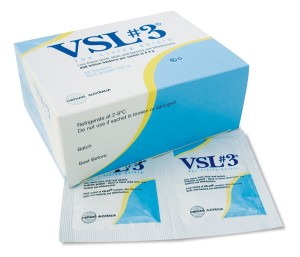I first became fascinated with probiotics in the early 2000’s. There was not much published literature, but there were a lot of theories about how the body’s bacterial population influenced overall health.
When I started writing my book in 2006, there was a larger body of literature. By the time my book was nearing completion in 2012, I had to re-write the whole chapter because of all the new scientific studies!
This morning a friend shared this article on Facebook: http://mobile.theverge.com/2013/8/21/4595712/gut-feelings-the-future-of-psychiatry-may-be-inside-your-stomach
I am excited to see where the future of probiotics takes us. I theorize that in 15-20 years, each person’s gut bacteria population will be mapped out… and they will create a probiotic tailored to their specific body to promote gut health. Or, maybe they will come up with a “perfect microbiome” and all probiotics will be geared toward getting everyone’s body to match that bacterial population.
Here is an excerpt on Probiotics and Prebiotics out of Chapter 8 of The Diarrhea Dietitian: Expert Advice, Practical Solutions, and Strategic Nutrition:
For over a decade, I have recommended a trial of probiotics to virtually all of my patients. Why? Of all the strategies I discuss with clients, adding probiotics has resulted in the most significant decrease in chronic diarrhea. Want to know if you need probiotics? Read on.
What Are Probiotics?
Probiotics are a vast group of living microbial organisms comprising normal gastrointestinal flora. Put simply, probiotics are good bacteria that are supposed to live in your intestinal tract. They protect you, the host, while preventing disease. An imbalanced bacterial population in your gut is also known as dysbiosis.
Examples of probiotics include bacterial species Lactobacillus and Bifidobacterium, as well as the Saccharomyces yeasts. In 1965, researchers coined the term “probiotics,” though the concept and use of beneficial bacteria to promote health had been around since the early 1900s. Scientists have agreed on four benefits of probiotics, despite not knowing their exact mechanisms(Sartor RB. Probiotics for gastrointestinal diseases. UpToDate®. Topic updated January 30, 2013):
- Suppress growth and prevent “bad” (disease-causing) bacteria from adhering to intestinal walls
- Maintain and stimulate the healthy cells of the intestinal lining to optimize immune function
- Enhance functioning of the immune system
- Modulate perception of pain
Other possible benefits of using probiotics:
- Signal cells to strengthen mucus in the intestine, providing a barrier against infection
- Destroy the toxins released by “bad” bacteria
What Are Prebiotics?
Prebiotics are nondigestible fibers and complex sugars that promote the growth and metabolic activity of the beneficial bacteria, primarily the Bifidobacterium, in the colon. They provide fuel for the probiotics already living in the intestine, favoring the good bacteria over the harmful ones. A prebiotic may be a fiber, but not all fibers are prebiotic.
Prebiotics were not defined until 1995. One example of a prebiotic is inulin, found in Jerusalem artichokes and asparagus stems. Fructooligosaccharides (FOS), which occur naturally in garlic, onions, green bananas, zucchini, watermelon, and peaches, are another type of prebiotic.
Health benefits of taking prebiotics:
- Possibly lowers cholesterol
- Increases stool weight
- Decreases transit time
- Increases calcium absorption
- Increases Bifidobacterium in the colon
Many reputable health resources recommend taking both prebiotics and probiotics. However, it is my experience that those who suffer from IBS-D (diarrhea predominant) or who are FODMAP-sensitive do not tolerate prebiotics; it exacerbates their diarrhea.
Synbiotics and Functional Foods
Fermented milk products such as yogurt and kefir are considered synbiotic because they contain both the live probiotic bacteria and the prebiotic fuel working synergistically. Products containing prebiotics, probiotics, or both are also called functional foods.
Functional foods exert a potentially positive effect on health beyond basic nutrition. One example is yogurt. Beyond the benefits of carbohydrate, protein, fat, and calcium contained in the yogurt itself, it contains active cultures of L. acidophilus, providing additional health benefits via probiotics. Functional food products containing prebiotics and/or probiotics include cereals, bread, beverages, yogurt, and nutritional supplements.
History of Probiotic Use
For thousands of years, the food we ate was unrefrigerated, unpasteurized, and unprocessed. Over the past hundred-plus years, the U.S. has improved food processing to prevent harmful bacteria and toxins from entering our food supply. While this has prevented many types of dangerous illnesses, it has resulted in fewer beneficial bacteria living in our gut as well.
Why Is It Important to Have Good Bacteria Living in Our Gut?
The intestine is our first line of defense against harmful pathogens, chemicals, and preservatives that we do not want in our bodies. In order to fight these invaders, the cells in the small intestine tightly line up next to each other, forming an impermeable barrier. Probiotics assist the cells in maintaining these tight junctions.
One leading scientific hypothesis proposes that dysbiosis allows tight junctions to loosen up, resulting in leaky gut syndrome or intestinal permeability. Openings created between the cells may permit proteins or toxins cross the intestinal barrier. Once the foreign invaders are inside, antibodies are created as the immune system is activated. Many autoimmune and gastrointestinal disorders have been linked to leaky gut syndrome; these include Crohn’s disease, celiac disease, Type 1 diabetes, psoriasis, and eczema.
What Makes a Good Probiotic?
To maximize their effectiveness, probiotics must remain stable in the acidity of the stomach and the alkalinity of the duodenum. Further down the GI tract, they must adhere to the surface of the small intestine and effectively populate the colon.
Dietary Sources of Probiotics
The dietary use of live bacteria dates back thousands of years. Yogurt is the most common and familiar form of probiotic, which contains primarily Bifidobacterium and Lactobacillus species. However, fermented dairy beverages such as kefir actually contain a higher concentration of live cultures. In today’s marketplace, you can also find probiotics in soup, cheese, energy bars, even cereal.
There is a downside to getting probiotics exclusively from food sources. It is very difficult to determine how much bacteria are surviving both the stomach acid and bile in order to assert their positive effects.
Probiotic Supplements
If my client is taking probiotics to “promote good gut health,” I support exclusive use of food sources of probiotics. However, if a patient is actively experiencing gastrointestinal symptoms from a known disease or disorder, I typically recommend they add an over-the-counter probiotic supplement to their daily regimen.
Probiotic supplements are formulated with a special coating to withstand stomach acid and bile before dissolving in the small intestine. Once the probiotics are released, they can adhere to the intestinal wall and support immune system function.
Probiotic Research
The past decade has seen an increase in the number of scientific studies on the effectiveness of probiotic supplements. However, one difficulty in creating a clinical trial is the wide variety of yeasts and bacteria species available. In scientific studies, many probiotics are used individually or in combination with other bacteria or yeasts. Studies have shown that some species are more effective in treating a particular disorder or disease.
Even more frustrating, not all probiotic supplements are alike. When independent companies test products, they find wide variability in the quantity and potency of live bacteria in each capsule. Many capsules do not even contain the quantity of live bacteria stated on the bottle.
Which Probiotic Should I Take and How Much?
It is challenging to provide detailed recommendations on which probiotic supplement to take and what dosage, due to variability in strength and viability. I do not recommend one particular brand over another, primarily because information changes quickly, and specific probiotics may be better-suited for a particular medical condition. The following table presents different conditions and the species of probiotic which has been scientifically studied and proven effective for that particular disease or disorder.
[Note: the book contains a chart here with different probiotic strains and what disease or disorder]
The International Scientific Association for Probiotics and Prebiotics (ISAPP), in The P’s and Q’s of Probiotics: A Consumer Guide for Making Smart Choices, recommends looking at these four criteria prior to choosing a probiotic. (http://www.isapp.net/docs/Consumer_Guidelines_final.pdf Accessed October 12, 2012)
- Probiotic Strain– Try to match the particular strain with published scientific research. This is challenging, but important. Not all products are equal.
- Proof– Probiotics must be tested on humans to determine health benefits. Does the product contain the same quantities as the published studies?
- Quality and Quantity- Probiotics can be effective at varying strengths. Scientific studies have determined health benefits from 50 million to over 1 trillion colony forming units (CFUs) per day. A probiotic with higher CFUs does not necessarily equal better quality or effectiveness.
- Package- What does the package label say? Strain, quantity of CFUs, serving size, health benefits, proper storage conditions, expiration date, and additional corporate contact information should all be included.
After making your choice based on the criteria above, I suggest taking one brand of probiotic for several weeks. (You may be able to obtain free samples by contacting a company directly.) If you do not notice significant improvement in your gas, bloating, or diarrhea after that time, don’t up—try a different brand.
Use the dosing recommended on the product label. Generally, dosing is one capsule two to three times per day on an empty stomach. If taking three capsules per day, take the first one right after you wake up, one in the afternoon, and the last one before bed. Guidelines for taking probiotics:
- Do not take the probiotic with a hot beverage or cereal, as the heat might destroy some of the good bacteria.
- Try probiotics for at least three to six months. Consider cutting back to one capsule a day after two months and note any changes.
- Eat yogurt (minimum 6-10 ounces per day) or kefir. Remember, not all live cultures in yogurt survive well in the acidic stomach environment.
- If taking prescription antibiotics, wait two hours before taking the probiotic so they do not cancel each other out. Remember, antibiotics will kill off both the good and bad bacteria. One exception: you may continue to take a yeast probiotic (such as FloraStor®), with your antibiotic. Antibiotics do not interfere with a yeast probiotic.
The following table lists some common name-brand probiotics that have been studied and proven effective in delivering the good bacteria to the intestine.
Brand-Name Probiotics and Their Targeted Treatments
|
Brand Name |
Type of Probiotic |
Primary treatment |
Website |
|
Align® |
-Bifidobacterium infantis 35624 |
-Overall digestive health -IBS |
|
|
Digestive Advantage® |
-Bacillus coagulans GBI-30, PTA-6086 |
-IBS -Lactose intolerance -Constipation |
http://digestiveadvantage.com/products.asp
|
|
Phillips’ Colon Health® |
-Lactobacillus gasseri KS-13 -Bifidobacterium bifidum G9-1 -Bifidobacterium longum MM-2
|
-Occasional constipation -Diarrhea -Gas, bloating |
|
|
Culturelle® |
-Lactobacillus Rhamnosus GG |
-Improved digestive function -Immune support |
|
|
FloraStor® |
-Saccharomyces boulardii lyo |
-C. Diff -IBD -HIV/AIDS-associated diarrhea |
|
|
Mutaflor® |
-Escherichia coli Nissle 1917 |
-Ulcerative colitis -Crohn’s disease -Chronic diarrhea -IBS -Pouchitis |
*Mutaflor® is no longer available for purchase in the US due the change in classification from “medical food” to “biologic” |
|
VSL #3® |
-Bifidobacterium breve -Bifidobacterium longum -Bifidobacterium infantis -Lactobacillus acidophilus -Lactobacillus plantarum -Lactobacillus paracasei -Lactobacillus bulgaricus -Streptococcus thermophilus |
-Ulcerative colitis -IBS -Ileal pouchitis |
Who Should NOT Take a Probiotic?
- People over 65 years old who are in poor health
- Young children
- People with comprised immune systems; especially avoid probiotics containing Saccharomyces yeasts
- Possibly those with Small Intestinal Bacterial Overgrowth
Do Probiotic Supplements Have any Side Effects?
Some people experience gas and bloating when beginning probiotics. It may take two to four weeks for those symptoms to subside while the good bacteria insert themselves into the intestine.
Occasionally, I will have a patient experience more severe symptoms when they first begin taking probiotic supplements. This reaction is sometimes referred to as the Jarisch-Herxheimer (or “Herx”) reaction. It occurs when the bad bacteria are dying off and the body is unable to release the toxins quickly enough. In the short-term—days to a few weeks—these toxins can exacerbate the symptoms being treated and cause more gas, bloating, or diarrhea. They may also create their own flu-like symptoms including headache, joint and muscle pain, body aches, sore throat, general malaise, sweating, chills, or nausea.
If you experience the Herx reaction, it is best to cut back on the dosage, while continuing to take probiotics until the toxins are eliminated from the body. Charcoal tablets taken about two hours after the probiotics can help bind and remove the toxins. Please discuss this with your doctor and pharmacist.
Once the harmful bacteria have been eliminated, it is time for the probiotics to do their job.
*******************
Don’t forget to take your probiotics today!






